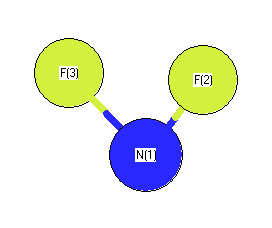Geometric Data

Point Group C2v
Internal coordinates
distances (r) in Å, angles (a) in degrees, dihedrals (d) in degrees
| Description |
Value |
unc. |
Connectivity |
Reference |
Comment |
| Atom 1 |
Atom 2 |
Atom 3 |
Atom 4 |
| rNF |
1.370 |
|
1 |
2 |
|
|
1966Herzberg |
!assumed |
| aFNF |
104.2 |
|
2 |
1 |
3 |
|
1966Herzberg |
|
These cartesians were determined using some assumed coordinate values.
Cartesians
| Atom |
x (Å) |
y (Å) |
z (Å) |
| N1 |
0.0000 |
0.0000 |
0.6059 |
| F2 |
0.0000 |
1.0810 |
-0.2356 |
| F3 |
0.0000 |
-1.0810 |
-0.2356 |
Atom - Atom Distances 
Distances in Å
| |
N1 |
F2 |
F3 |
| N1 |
|
1.3700 | 1.3700 |
| F2 |
1.3700 |
|
2.1621 |
| F3 |
1.3700 | 2.1621 |
|
Calculated geometries
for NF
2+ (Difluoroamino cation).
Experimental Bond Angles (degrees) from cartesians 
| atom1 |
atom2 |
atom3 |
angle |
| F2 |
N1 |
F3 |
104.200 |
Bond descriptions
Examples: C-C single bond, C=C, double bond, C#C triple bond, C:C aromatic bond
Connectivity
| Atom 1 |
Atom 2 |
| N1 |
F2 |
| N1 |
F3 |











